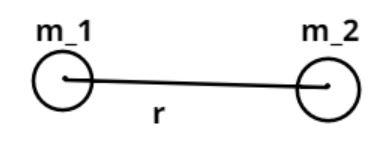
Two celestial bodies are separated by some distance. If the mass of any one of the points is doubled while the mass of the other is halved then how far should they be taken so that the gravitational force between them is one-fourth?
Answer
589.5k+ views
Hint – In this question let ${m_1}$ be the mass of the first body and the mass of the second celestial body be${m_2}$. Use the direct relationship between the force, masses and the distance between two bodies that is ${F_g} = G\dfrac{{{m_1}{m_2}}}{{{r^2}}}$. Since the masses are now changed therefore application of the same formula will help yielding two different equations. Use them to get the answer.
Step by step answer:

Let the first celestial body have mass ${m_1}$ and the second celestial body having mass${m_2}$.
Let them are separated by the distance r as shown in the figure.
As we know that the gravitational force (${F_g}$) working between these two bodies is given as
$ \Rightarrow {F_g} = G\dfrac{{{m_1}{m_2}}}{{{r^2}}}$...................... (1)
Where, G = universal gravitational constant.
Now it is given that the mass of any one body is doubled and the mass of the other body is halved and the gravitational force working between them is one-fourth of the previous one.
Let mass of first body = ${m_3}$
And mass of other body = ${m_4}$
Let the force between them = ${F'_g}$
Therefore, ${m_3} = 2{m_1}$
And ${m_4} = \dfrac{1}{2}{m_2}$
And, ${F'_g} = \dfrac{1}{4}{F_g}$
Let the distance between them is (d).
So the gravitational force between them is
$ \Rightarrow {F'_g} = G\dfrac{{{m_3}{m_4}}}{{{d^2}}}$
Now substitute the values we have,
$ \Rightarrow \dfrac{{{F_g}}}{4} = G\dfrac{{2{m_1}\left( {\dfrac{1}{2}{m_2}} \right)}}{{{d^2}}}$
$ \Rightarrow \dfrac{{{F_g}}}{4} = G\dfrac{{{m_1}\left( {{m_2}} \right)}}{{{d^2}}}$............. (2)
Now divide equation (1) from equation (2) we have,
$ \Rightarrow \dfrac{{{F_g}}}{{\dfrac{{{F_g}}}{4}}} = \dfrac{{G\dfrac{{{m_1}{m_2}}}{{{r^2}}}}}{{G\dfrac{{{m_1}\left( {{m_2}} \right)}}{{{d^2}}}}}$
Now simplify this equation we have,
$ \Rightarrow 4 = \dfrac{{{d^2}}}{{{r^2}}}$
Now take square root on both sides we have,
$ \Rightarrow \sqrt 4 = \sqrt {\dfrac{{{d^2}}}{{{r^2}}}} $
$ \Rightarrow \dfrac{d}{r} = 2$
$ \Rightarrow d = 2r$
So the separation between the bodies should be doubled.
So this is the required answer.
Note – There is often a confusion between g and G. g is the acceleration due to gravity whose value is 9.8 at the surface of the earth however G is the proportionality constant and has a default value of $6.674 \times {10^{ - 11}}{m^3}K{g^{ - 1}}{s^{ - 2}}$. It is advised to remember the direct formula for the force of gravitation between two masses that is ${F'_g} = G\dfrac{{{m_3}{m_4}}}{{{d^2}}}$.
Step by step answer:

Let the first celestial body have mass ${m_1}$ and the second celestial body having mass${m_2}$.
Let them are separated by the distance r as shown in the figure.
As we know that the gravitational force (${F_g}$) working between these two bodies is given as
$ \Rightarrow {F_g} = G\dfrac{{{m_1}{m_2}}}{{{r^2}}}$...................... (1)
Where, G = universal gravitational constant.
Now it is given that the mass of any one body is doubled and the mass of the other body is halved and the gravitational force working between them is one-fourth of the previous one.
Let mass of first body = ${m_3}$
And mass of other body = ${m_4}$
Let the force between them = ${F'_g}$
Therefore, ${m_3} = 2{m_1}$
And ${m_4} = \dfrac{1}{2}{m_2}$
And, ${F'_g} = \dfrac{1}{4}{F_g}$
Let the distance between them is (d).
So the gravitational force between them is
$ \Rightarrow {F'_g} = G\dfrac{{{m_3}{m_4}}}{{{d^2}}}$
Now substitute the values we have,
$ \Rightarrow \dfrac{{{F_g}}}{4} = G\dfrac{{2{m_1}\left( {\dfrac{1}{2}{m_2}} \right)}}{{{d^2}}}$
$ \Rightarrow \dfrac{{{F_g}}}{4} = G\dfrac{{{m_1}\left( {{m_2}} \right)}}{{{d^2}}}$............. (2)
Now divide equation (1) from equation (2) we have,
$ \Rightarrow \dfrac{{{F_g}}}{{\dfrac{{{F_g}}}{4}}} = \dfrac{{G\dfrac{{{m_1}{m_2}}}{{{r^2}}}}}{{G\dfrac{{{m_1}\left( {{m_2}} \right)}}{{{d^2}}}}}$
Now simplify this equation we have,
$ \Rightarrow 4 = \dfrac{{{d^2}}}{{{r^2}}}$
Now take square root on both sides we have,
$ \Rightarrow \sqrt 4 = \sqrt {\dfrac{{{d^2}}}{{{r^2}}}} $
$ \Rightarrow \dfrac{d}{r} = 2$
$ \Rightarrow d = 2r$
So the separation between the bodies should be doubled.
So this is the required answer.
Note – There is often a confusion between g and G. g is the acceleration due to gravity whose value is 9.8 at the surface of the earth however G is the proportionality constant and has a default value of $6.674 \times {10^{ - 11}}{m^3}K{g^{ - 1}}{s^{ - 2}}$. It is advised to remember the direct formula for the force of gravitation between two masses that is ${F'_g} = G\dfrac{{{m_3}{m_4}}}{{{d^2}}}$.
Recently Updated Pages
Master Class 12 Business Studies: Engaging Questions & Answers for Success

Master Class 12 Economics: Engaging Questions & Answers for Success

Master Class 12 English: Engaging Questions & Answers for Success

Master Class 12 Maths: Engaging Questions & Answers for Success

Master Class 12 Social Science: Engaging Questions & Answers for Success

Master Class 12 Chemistry: Engaging Questions & Answers for Success

Trending doubts
Which animal has three hearts class 11 biology CBSE

1 Quintal is equal to a 110 kg b 10 kg c 100kg d 1000 class 11 physics CBSE

Explain zero factorial class 11 maths CBSE

The camels hump is made of which tissues a Skeletal class 11 biology CBSE

How do I convert ms to kmh Give an example class 11 physics CBSE

The percentage of free SO3 in oleum sample which is class 11 chemistry CBSE




